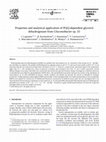Papers by B. Kurtinaitiene
Talanta, 2000
Partially hydrolyzed polyarbutin-containing benzoquinone groups were synthesized by using chemoen... more Partially hydrolyzed polyarbutin-containing benzoquinone groups were synthesized by using chemoenzymatic methods. This polymer was used as a mediator for the oxidation of pyrroloquinoline quinone-dependent glucose dehydrogenase. Polymer was covalently attached to the enzyme through the glucose moiety of the polymer and amine residues in the protein. Electrochemical studies show that the oxidized benzoquinone attached to the enzyme can act as a mediator for the reoxidation of the enzyme at carbon electrode surfaces. The apparent Michaelis constant and inactivation rate constant of the coupled enzyme were found to be similar to these parameters of the native enzyme.
Biosensors and Bioelectronics, 2008
A new amperometric immunosensor for detection of antibodies against bovine leukemia protein (gp51... more A new amperometric immunosensor for detection of antibodies against bovine leukemia protein (gp51) was designed. The detection of antibody-antigen complex formation was based on application of secondary antibodies labeled with horseradish peroxidase (HRP). Ferrocenecarboxylic acid (FCA) and N,N,N ,N -tetramethylbenzidine (TMB) were selected as suitable mediators for this immunosensor. Optimal conditions for amperometric detection were found. Sensitivity of created system was compared with the results of enzyme-linked immunosorbent assay (ELISA) and agar gel immunodiffusion (AGID) reaction, and was sufficient for detection of usual anti-gp51 antibody concentration present in the blood serum of BLV-infected cattle.
Bioelectrochemistry, 2002
This paper focuses on the use of PQQ-dependent enzymes (PQQ enzymes) in amperometrical biosensors... more This paper focuses on the use of PQQ-dependent enzymes (PQQ enzymes) in amperometrical biosensors and gives emphasis on their innovative designs and applications. The study covers some aspects in the evolution of biosensors based on PQQ enzymes. Main attention is focused on the electrochemical properties of PQQ enzymes as very promising materials for the formation of electrochemical biosensors. Immobilization approaches and redox mediators recently used in PQQ enzymes based biosensors are reviewed. The acceptance of polypyrrole as a very promising immobilization matrix for some PQQ enzymes is discussed. D
Analytica Chimica Acta, 1996
Glycerol dehydrogenase (GDH) and lipase have been used for the amperometric determination of glyc... more Glycerol dehydrogenase (GDH) and lipase have been used for the amperometric determination of glycerol and triglycerides on modified carbon electrodes. Carbon electrodes were modified with adsorbed Meldola Blue, Nile Blue or Toluidine Blue O. Electrochemical oxidation of NADH was realized at 0V vs saturated Ag/AgCl electrode. NADH was produced by the catalytic oxidation of glycerol in the presence of glycerol

Analytica Chimica Acta, 2005
PQQ-dependent glycerol dehydrogenase (GlyDH) was purified from Gluconobacter sp. 33. Activation o... more PQQ-dependent glycerol dehydrogenase (GlyDH) was purified from Gluconobacter sp. 33. Activation of this enzyme by Ca ++ and Mg ++ ions and PQQ was analysed. The purified GlyDH displayed an optimum activity at pH 7.0-7.5 and was the most stable at pH 8.5-9.5. It was determined that the rate of glycerol oxidation had a maximum at 33-37 • C. However, a rapid enzyme inactivation began at the temperatures higher than 35 • C. The calculated K M values for glycerol, d-sorbitol, and d-mannitol were 0.83, 1.0, and 2.4 mM, respectively. Several different designs of enzymatic electrodes were constructed and involved into glycerol biosensor design. Investigation of substrate selectivity of immobilised (cross-linked by glutaraldehyde) GlyDH shows, that immobilisation procedure decreases the activity of the membranes of Gluconobacter sp. 33 cells (mGlyDH) for glucose, sorbitol, mannitol, and ethanol, but increases the activity of mGlyDH for methanol and dulcitol. Soluble phenazine methosulphate (PMS) and insoluble 4-ferrocenylphenol (FP), N-(4-hydroxybenzylidene)-4-ferrocenylaniline (HBFA) were applied for construction of GlyDH-based biosensors. Inactivation of GlyDH by heavy metal ions was investigated and it was observed that biosensors based on membranes of Gluconobacter sp. 33 cells (mGlyDH) and purified PQQ-dependent glycerol dehydrogenase (pGlyDH) were sensitive to Pb ++ , Cd ++ , Co ++ , Cu ++ , Ni ++ , and Hg ++ . Possibility to apply GlyDH-based biosensors for detection of glycerol and triglycerides in real wine samples was shown. (I. Lapenaite), arunas@imi.lt (A. Ramanavicius). more effective , especially in the cases if PQQ-dependent enzyme has no hemes incorporated into its structure [7]. PQQ is directly responsible for a redox conversion of the substrate, and thus it has been evaluated as the next major coenzyme following pyridine nucleotide and flavin in biological oxidoreduction .









Uploads
Papers by B. Kurtinaitiene